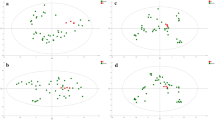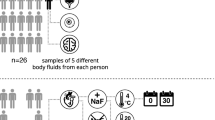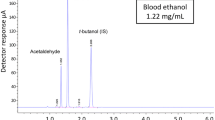Abstract
We previously established a sensitive gas chromatography–mass spectrometry method for analysis of ethylene glycol (EG), propylene glycol (PG), and diethylene glycol (DEG), and disclosed the presence of appreciable amounts of EG, PG, and DEG in fresh whole blood and urine specimens obtained from nonoccupational healthy humans. These results led us to analyze EG and PG in specimens taken from three human cadavers. EG and PG concentrations in the postmortem blood and solid tissues were much higher than those found in fresh whole blood; their concentrations in many postmortem specimens were more than tenfold those in fresh whole blood specimens, suggesting the postmortem production of EG and PG. Therefore, we examined the time courses of EG and PG concentrations in blood specimens in the absence and presence of saprogenic blood (10 % volume) and/or glucose (3 mg/ml) in vitro, which were left at room temperature for 7 days. EG concentration in fresh blood without any addition decreased slightly during the 7 days. EG concentration in the blood with addition of glucose, and PG concentrations in the blood with and without addition of glucose did not change appreciably during the 7 days. EG and PG concentrations in the blood after addition of 10 % saprogenic blood increased 3.1-fold and 3.5-fold after 7 days, respectively; those after addition of saprogenic blood plus glucose increased 9.1-fold and 11.9-fold after 7 days, respectively. These results show that microorganisms present in the saprogenic blood caused the postmortem production of EG and PG, and the addition of glucose further enhances the EG and PG concentrations, probably acting as the substrate for glycol production by the microorganisms. To our knowledge, this is the first report to describe postmortem production of EG and PG in human specimens.



Similar content being viewed by others
References
Baselt RC (2004) Disposition of toxic drugs and chemicals in man, 7th edn. Biomedical Publications, Foster City, pp 332–333, 425–428, 960–961
Wurita A, Suzuki O, Hasegawa K, Gonmori K, Minakata K, Yamagishi I, Nozawa H, Watanabe K (2013) Sensitive determination of ethylene glycol, propylene glycol and diethylene glycol in human whole blood by isotope dilution gas chromatography–mass spectrometry, and the presence of appreciable amounts of the glycols in blood of healthy subjects. Forensic Toxicol 31:272–280
Wurita A, Suzuki O, Hasegawa K, Gonmori K, Minakata K, Yamagishi I, Nozawa H, Watanabe K (2013) Presence of appreciable amounts of ethylene glycol, propylene glycol, and diethylene glycol in human urine of healthy subjects. doi: 10.1007/s11419-013-0206-5
Nanikawa R, Moriya F, Hashimoto Y (1988) Experimental studies on the mechanism of ethanol formation in corpses. Z Rechtsmed 101:21–26
Ziavrou K, Boumba VA, Vougiouklakis TG (2005) Insights into the origin of postmortem ethanol. Int J Toxicol 24:69–77
Yajima D, Motani H, Kamei K, Sato Y, Hayakawa M, Iwase H (2006) Ethanol production by Candida albicans in postmortem human blood samples: effects of blood glucose level and dilution. Forensic Sci Int 164:116–121
Boumba VA, Ziavrou KS, Vougiouklakis T (2008) Biochemical pathways generating post-mortem volatile compounds co-detected during forensic ethanol analyses. Forensic Sci Int 174:133–151
Boumba VA, Economou V, Kourkoumelis N, Gousia P, Papadopoulou C, Vougiouklakis T (2012) Microbial ethanol production: experimental study and multivariate evaluation. Forensic Sci Int 215:189–198
Zhu J, Feng Y-L, Aikawa B (2004) A positive chemical ionization GC/MS method for the determination of airborne ethylene glycol and propylene glycols in non-occupational environments. J Environ Monit 6:881–887
Conflict of interest
There are no financial or other relations that could lead to a conflict of interest.
Author information
Authors and Affiliations
Corresponding author
Rights and permissions
About this article
Cite this article
Wurita, A., Suzuki, O., Hasegawa, K. et al. Occurrence of postmortem production of ethylene glycol and propylene glycol in human specimens. Forensic Toxicol 32, 162–168 (2014). https://doi.org/10.1007/s11419-013-0210-9
Received:
Accepted:
Published:
Issue Date:
DOI: https://doi.org/10.1007/s11419-013-0210-9




